Though they are pretty and bees love them, I’d rather my onions not make flowers. Why? Because the flower stalk ruins the core of the bulb.
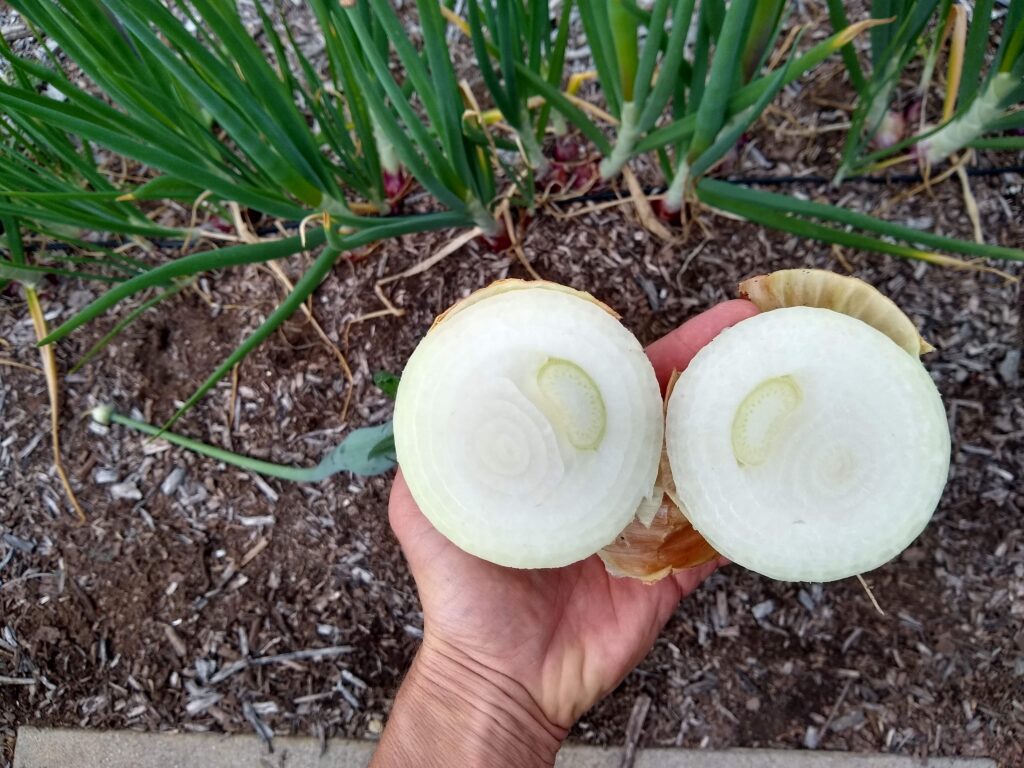
Once the onion plant sends up a flower stalk there is nothing you can do to stop the process, and the center of the bulb eventually dries and becomes hollow. Onions that have flowered do not store as long either.
Last spring (2023), many of my onions sent up flower stalks. It irritated me so much that I researched the process thoroughly and went through my notes on previous years’ onion crops. Here’s what I learned.
Three contributing factors
According to my California Master Gardener Handbook there are three potential causes of flowering. The book states that “seedstalks develop” because of “cold weather after plants are 6-10 weeks old,” and that a gardener must “plant [the] right variety at [the] proper time.”
So we have: (1) cold weather; (2) variety; and (3) planting time.
Planting date
For the past nine years, I’ve kept records of my onion plantings so I looked at my sowing and planting dates to see if I could find a correlation with flowering. I found one. I found that, in general, the earlier the sowing date, the more flowering.
Specifically, my onion crops sown between September 14 and October 12 have flowered a lot whereas my onion crops sown on October 17 or later have flowered only a little or not at all.
Sowing onions later than November resulted in little flowering but it also resulted in smaller bulbs.
Right variety
My records show that only one variety has produced excellent bulbs and never flowered: Gabriella. But it’s not clear that the variety is key here because I only grew it two years and both years I sowed after mid-October. So was it the variety or the later sowing date?
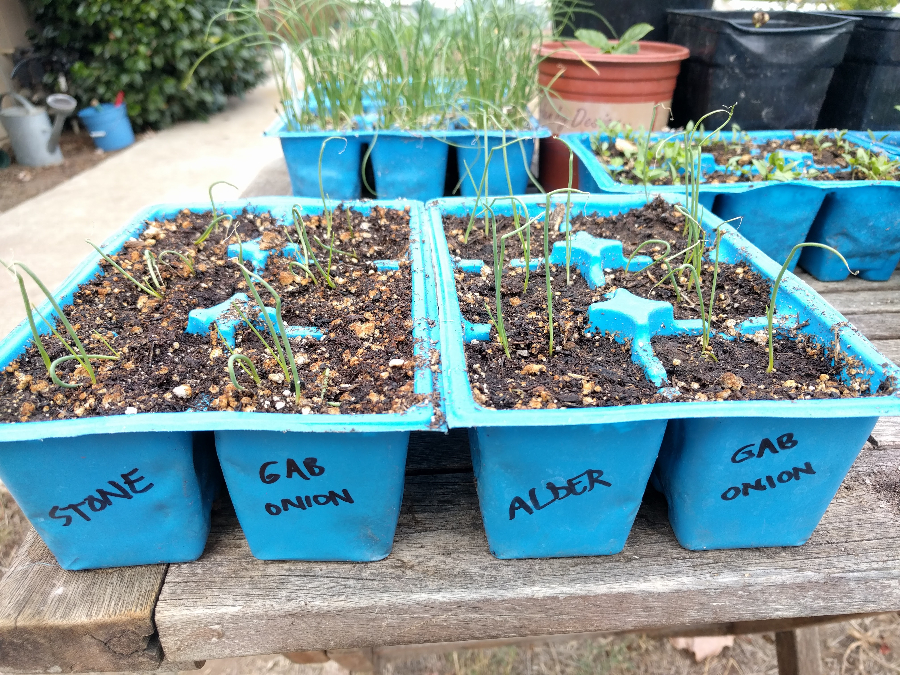
A variety named Madalyn had zero bolting one year but had some flowering in the two other years I’ve grown it, including this year.

The year that Madalyn had zero flowering had the latest sowing date (October 24, 2020). Here is the harvest of that sowing:

That same year, I sowed Red Rock onions on the same date. Very few of those plants bolted.
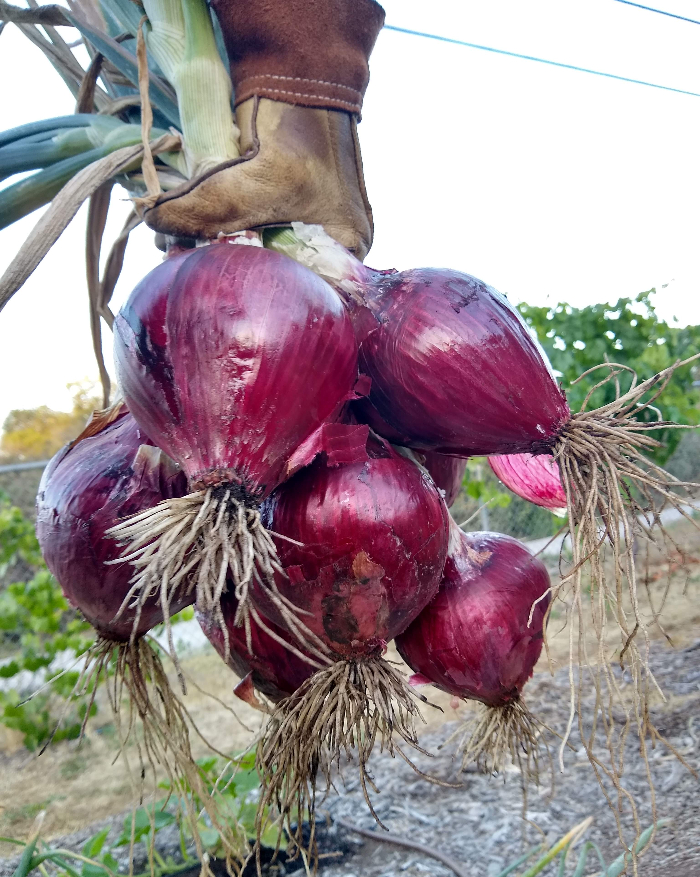
There have been some varieties that have always bolted a lot on me, such as White Castle.
So from my experience, it does seem that varieties have different tendencies toward bolting. And combining a later sowing date with a variety that resists bolting might find best success.
Cold weather
The California Master Gardener Handbook did not say that cold weather causes or prevents onions from flowering. It said that “cold weather after plants are 6-10 weeks old” causes onions to flower.
Did you know that there are farms in Southern California that grow onions for seed production — not for bulbs, but for seeds? These farms are in the Imperial Valley. These farmers actually want their onions to flower, for that is how they get seed.
And look at how they achieve this flowering: “Onion seed are planted in the field in August or September. Planting must be early enough for the plants to attain sufficient size to be vernalized.”
Vernalized? “Seed stalk formation requires a period of cooling known as vernalization. Induction of flowering occurs when plants or bulbs are subjected to temperatures of 45-55 degrees F for approximately one month or longer.”
(See “Onion seed production in California.”)
What does this mean? In order to achieve onion flowering, the seed farmers plant early enough (August or September) such that the plants experience cold weather when the plants have grown for a couple of months already. Experiencing the cold while they are younger and smaller will not cause the plants to flower reliably. Hence a later planting date (say, October or November) is not advised because the plants would be too small during the cold weather of winter and would not be vernalized.
Aha! It sounds like if we don’t want our onions to flower, we should plant later than the farmers who grow for seed production.
To further support this is another University of California publication called “Fresh-market bulb onion production in California” which says, “Bolting is primarily driven by temperature when plants with a leaf base greater than approximately 3/8 inch in diameter are subjected to temperatures of 45 to 50 degrees F.”
Conclusions
I’ve been planting too early, sometimes. My new rule of thumb will be to sow only after mid-October and through November. Planting dates (from six-pack size or smaller) can be in November through December, for best bulb size and least flowering.
As for varieties, I’ve had the best production and least flowering from Gabriella. I should stick with it as my main variety.
This winter was unusually cold and long. That likely vernalized some onions that wouldn’t have flowered as much in warmer, shorter winters. So I’ll cut myself a little slack and blame part of my flowering on the weather.
But this is what I’d like to see more of (sorry, bees):
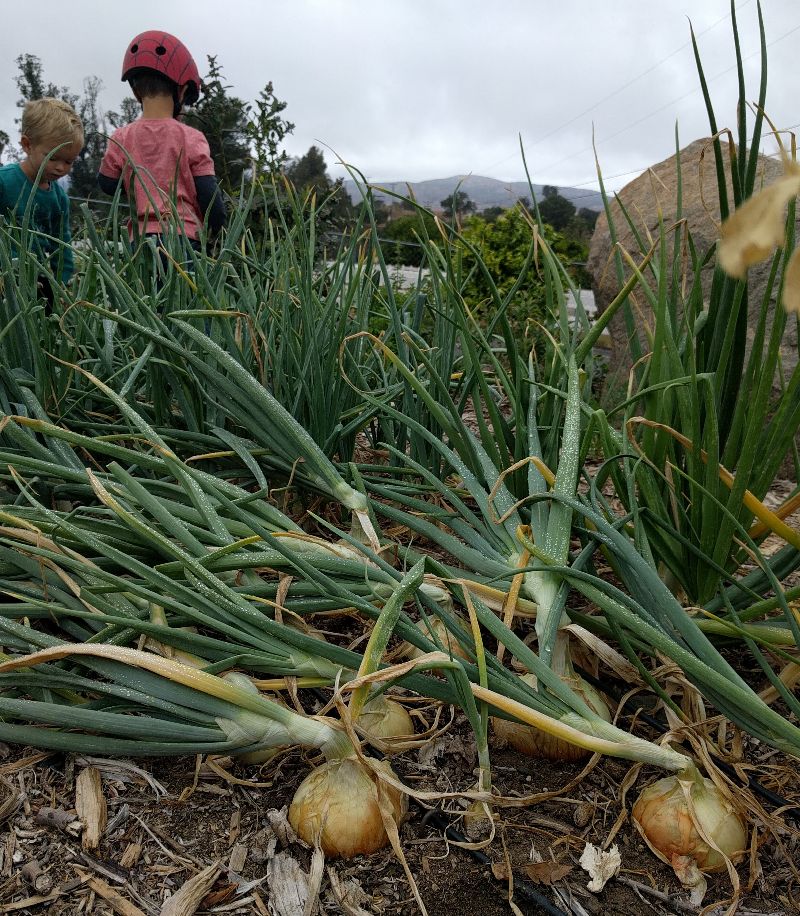
Spring 2024 results
A gardening friend who lives in the neighboring town here in San Diego County visited last week, pointed to my row of onions, and said, “Are those your onions? No flowers?”
“Yeah, those are my onions. Right, no flowering this year.”
“Mine are flowering. It’s because of the cold nights during winter,” he said.
But my yard gets colder than his. And I clearly remembered that when I visited his place in mid-November, I had seen his onions; they were already large, looking like they had been planted at least a month prior, whereas I hadn’t even planted mine yet. (I sowed mine on October 31, 2023, and planted them on December 5.)
He planted too early. That’s at least partly why his bolted.
I would have said all of this but I didn’t because he was on his way and we didn’t have time to discuss it. So here I am now. I’ll send him this post, the main point of which is this:
If you want to reduce onion flowering in Southern California, don’t sow them until late October, and don’t plant them until late November.
You might like to read my post, “Growing onions in Southern California.”
All of my Yard Posts are listed here.
It’s been more than a year since I ran an ad on The Yard Posts, and that is because of your support.

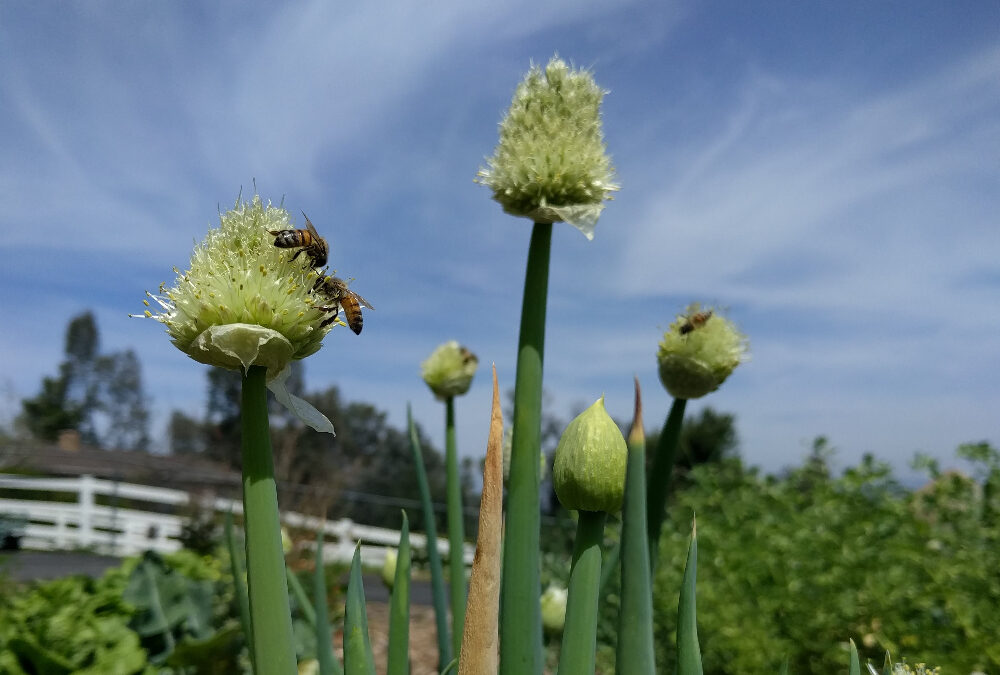


Awesome sleuthing! I appreciate hearing about the process you use to figure out problems and arrive at best planting dates. Is mid October when I should direct seeds, or should I start seeds sooner and plant transplants then?
Hi Jessica,
Thank you! Good question. It seems that mid-October is the earliest to start sowing seeds, and then around mid-December would be the earliest to start transplanting seedlings — for the least flowering and biggest bulbs, at my location.
Awesome, thanks. Trying to get better about setting reminders in my calendar so I start things on time. I’m in Lakeside, and so far the dates seem to be pretty dead on.
Ramblings that you don’t have to actually read, haha: I did have my broccoli started late Sept (from seed) bolt, but that might have been low nitrogen. Otherwise dates seem pretty dead on. You’d think we signed a contract with nature to lock in spring on April 15th so we could plant out our spring crops. I did have kind of an interesting result with planting some tomato plants early. This year for the first time, I put my tomato starts outside during the day instead of using lights. They grew much faster, to the point that by mid March I realized keeping them going through April 15th would be a huge pain– they were outgrowing pots in a few days and sulking as soon as their roots hit the edges, and they needed water constantly. So I planted out four or five plants that were duplicates, figuring it was no big loss if they didn’t make it. Half of them died right away, though I actually think this was because I covered them with plastic jugs and they cooked on a hot day. The remaining two did virtually nothing until mid April, so I had written off planting tomatoes that early. But now they’re growing like crazy, outpacing the new transplants, and they have these nice, sturdy stalks. It wasn’t very scientific because I chose the largest plants to plant out early, but I still found it kind of intriguing, especially because I didn’t really give them any care while they were in the ground (aside from maybe turning on the irrigation), while the transplants I had held back were pretty high maintenance given their size. In that vein, I planted out my cucurbits a little early on April 15th, with extra transplants held in reserve. The cucs don’t seem too happy, but the winter squash and zucchini seem fine so far (The starts are maybe 2 weeks old, so I did douse them in DE to give them a fighting chance against the pincher bugs and rollie pollies). Killing plants probably isn’t practical for a large grower, but my goal is generally to have one healthy plant of each variety, so I don’t mind tinkering and losing some. All that said, it’s probably time to shift attention to my passionfruit and young citrus, which are looking pretty miserable. I’ve also been learning about companion planting recently and am looking forward to experimenting with that once my zinnia/cosmo/alyssum starts get a little bigger! As always thanks for the reply and for the blog. It’s my favorite by far, and I recommend it all the time!
Grateful for the ramblings, Jessica! This spring has been disorienting. You think it has warmed up for good and then it’s back in the 60s and showery. I still have so many earwigs, pill bugs, and snails in the yard.
Some neighbors told me yesterday that they got impatient with their tomatoes outgrowing pots and put half in the ground only to have them frozen a couple nights later.
I have been extra cautious and patient with my warm-season vegetables this spring and so far it is paying off, but it is annoying to do so much up-potting.
But I also see two contradictory and confusing things happening in my vegetable beds today. My late brassica plantings are not growing well even though the weather seems mild enough for them to thrive. I need another scapegoat for explanation there. Meanwhile, one of my rows of tomatoes is doing well but another looks stunted from cold soil. I’ve got to dig around and do some more thinking on these.
My earwigs are worse than I’ve ever seen them, outside and in. Hopefully it’s the rain this year and not a new trend!
Good morning Greg!
Onions going to seed have always vexed me so it was an interesting read for me. When touching on the three reasons cold stood out, however, when talking varieties one major thing to note is the three types of varieties available, short, neutral and long day varieties. Planting the wrong type for your area will make a huge difference in the size of your crop.
Cheers! Bob
Hi Bob,
I kept the topic of day-length categories out of the post just to keep it focused, but I have tried many intermediate and long-day varieties over the years too. In general, my records show that the amount of flowering correlates to sowing/planting time just like with the short-day varieties.
I’ve always had good size bulbs from intermediate and long-day varieties, but I’ve also always had more flowering compared to short-day varieties. The other difference I’ve noticed is that the intermediate and long-day varieties mature much later. I harvest short-day varieties in May/June whereas the intermediate and long-day varieties aren’t ready until July/August even though I sow them all at the same time.
Here’s a post I wrote back in 2015 when I first experimented with long-day varieties: https://gregalder.com/yardposts/you-sure-can-grow-long-day-onions-in-southern-california/
I cheat. 3 years ago I bought yellow onion sets from Home Depot, and planted them in 15 Gal pots with auto watering. About 6 per pot. Not knowing better, I let them grow…..and grow! Only a couple flowered. Not exaggerating, one grew 7″ dia, and most grew 5″-6″ dia. We cut big chunks from them and ate them like apples with supper, they were so delicious. I missed last year, but found them again this year. Planted the sets in Jan, and they are growing quite well so far.
I always planted shallots on Halloween with good results. They don’t mind pretty close planting. Nothing eats them and they don’t get diseases. Easy peasy in So. Cal. Buy them once and keep planting the bulbs.